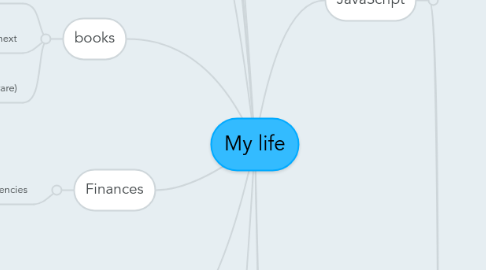
1. Finances
1.1. dependencies
1.1.1. FritoLay
2. Fitness
2.1. dependencies
2.1.1. mindfulness & planning
2.2. running
2.2.1. if class+crossfit club don't kill me, then need 2 run more
2.3. biking
2.3.1. doing cross fit instead of gym membership so no more biking?
2.4. strength
2.4.1. class Tues/Wed/Thurs
2.4.2. crossfit club
3. Sideprojects
3.1. software
3.1.1. to refactor
3.1.1.1. IoT dashboard
3.1.1.2. healthhub
3.1.1.3. Github resume escalator
3.1.1.4. Twitter robot
3.1.1.5. Good buddy trucking dashboard
3.1.1.6. automated journalist
3.1.2. current
3.1.2.1. frugal app
3.1.2.2. poll system
3.2. people
3.2.1. leadership
3.2.1.1. STATEWARE
3.2.1.2. AAD
3.2.2. membership
3.2.2.1. Nittany Data Labs
3.3. dependencies
3.3.1. finances
4. books
4.1. Finish and review
4.1.1. David and Goliath
4.1.2. Tipping Point
4.2. read next
4.2.1. Blink
4.3. read next (software)
4.3.1. Javascript the good parts
4.3.2. Javascript design patterns
5. current priorities
5.1. 1 Financial health
5.1.1. dependencies
5.1.1.1. FritoLay performance
5.2. 2 FritoLay success
5.2.1. dependencies
5.2.1.1. diet planning
5.2.1.2. Fitness
5.2.1.3. laundry planning
5.2.1.4. mindfulness
5.2.1.5. sleep
5.3. 3 Fitness
5.3.1. dependencies
5.3.1.1. mindfulness
5.4. 4 House
5.4.1. dependencies
5.4.1.1. mindfulness & planning
5.5. 5 Sofware Career
5.5.1. dependencies
5.5.1.1. software knowledge (breadth)
5.5.1.2. Financial health
5.5.1.3. software experience (depth)
6. Lean Six Sigma
6.1. Project Sponsor
6.2. Project Leader
6.3. Lean
6.4. DMAIC
6.4.1. Define
6.4.2. Measure
6.4.3. Analyze
6.4.4. Improve
6.4.5. Control
6.5. Six Sigma
6.6. Net Productivity
6.7. TIMWOODS
7. GPA
7.1. To be continued Fall 2016
8. Coffee
8.1. brewing methods
8.1.1. chemex
8.1.2. french press
8.1.3. cold brew
8.1.4. pour over
8.2. stop spending money here
9. 1 Establish how I internally categorize every area and interest of my life 2 Establish my priorities and what their dependencies are 3 Plan my time (hours or days) by priorities --> if the item doesn't exist within the tree of that priority, I can't touch it nor think about it.
9.1. Example: 7pm and later on a worknight, I can't touch javascript nor software projects, but I can do laundry or make my lunch... - Also just purposely/mindfully choose/create a task that fits in or strengthens a tree, can't just keep randomly learning stuff all the time, I end up forgetting more of it
9.1.1. (bad to plan tasks for time ranges, but good to plan general priorities during time ranges... i.e., Friday+Saturday == Javascript... later can decide Friday === study monads && Saturday == side project work... even later can decide Saturday == make progress on Frugal App essentially top-down approach to planning tasks.. so that I'm always motivated to do the tasks, understand why im doing said task, etc... maximizes motivation and constrains focus a little in positive way
10. mindfulness - purposely doing small task with larger end-goal in mind
10.1. priorities change depending on the hour, day, week, month, year, any time-frame/etc tasks change depending on the priority, they don't change depending on the time (why most people fail at planning)
11. JavaScript
11.1. frameworks / libraries
11.1.1. frontend
11.1.1.1. React / Redux
11.1.1.1.1. immutable.js
11.1.1.2. Angular
11.1.2. backend
11.1.2.1. Express
11.1.3. highland.js
11.2. language stepping stones
11.2.1. prototype chain
11.2.2. function scope
11.2.3. lexicographical scope / block scope
11.2.4. var
11.2.5. let
11.2.6. const
11.2.7. this
11.2.8. context
11.2.9. bind
11.2.10. apply
11.2.11. call
11.2.12. Object
11.2.13. .sort()
11.2.13.1. for numbers: .sort((a,b) => {return a-b});
11.2.14. Date object
11.2.15. Array objects
11.2.15.1. map
11.2.15.2. reduce
11.2.15.3. filter
11.2.15.4. pop
11.2.15.5. push
11.2.15.6. join
11.2.16. String objects
11.2.16.1. split
11.2.16.2. toLowerCase
11.2.16.3. toUpperCase
11.2.17. callback functions
11.2.17.1. async
11.2.18. callback hell
11.2.19. closures
11.2.19.1. solution to callback hell
11.2.20. promises
11.2.21. generators
11.2.21.1. use case for generators with promises
11.3. software related concepts
11.3.1. design patterns
11.3.1.1. MVC
11.3.1.2. Flux architecture
11.3.1.3. OOP
11.3.1.3.1. inheritance
11.3.1.3.2. encapsulation
11.3.1.3.3. polymorphism
11.3.1.4. MVVM
11.3.1.5. Monolith oriented architecture
11.3.1.6. Microservice oriented architecture
11.3.2. misc
11.3.2.1. Ajax
11.3.2.2. REST api's
11.3.2.2.1. http requests
11.3.2.2.2. Richardson Maturity Model
11.3.2.2.3. JSON
11.3.2.3. web sockets
11.3.2.3.1. sockets.io
11.3.2.4. Web API
11.3.2.4.1. DOM
11.3.3. TDD
11.3.3.1. Unit Testing
11.3.3.1.1. mocha
11.3.3.1.2. chai
11.3.3.2. the importance of minimizing feedback loops
11.3.4. Functional programming
11.3.4.1. Monad
11.3.5. Software Teams
11.3.5.1. Agile
11.3.5.1.1. Manifesto
11.3.5.1.2. Scrum
11.3.5.2. Communication
11.3.5.2.1. Slack
11.3.5.3. Product Management
11.3.5.3.1. Roadmapping
11.3.5.3.2. Prioritization
11.3.5.3.3. Specifications
11.3.5.3.4. low-fidelity vs high-fidelity prototyping
11.3.5.3.5. wireframing
11.3.5.3.6. A/B testing
11.3.5.3.7. User research
11.3.5.4. DevOps
11.3.5.4.1. Continuous integration
11.3.5.4.2. Continuous deployment
11.3.5.5. Security
11.3.5.5.1. OWASP
11.3.5.6. Source / Version Control
11.3.5.6.1. Github
11.3.5.6.2. Gitlabs
11.3.5.6.3. Git
11.3.6. My personal stages of development:
11.3.6.1. 1 conceptualize idea
11.3.6.2. 2 wireframes and state machines to demonstrate design of functionality (foundations for UX)
11.3.6.3. 3 UI development --> enabled by UX values & functional design
11.3.6.4. 4 aggregate all data/info outputs on all UI screens
11.3.6.5. 5 map every output to an input data/info entity
11.3.6.6. 6 design back-end database schemas (Table schemas or document schemas)
11.3.6.7. 7 use Agile principles of development (use Sprints, re-iterate, focus on features and user stories, use cross-functional developers/etc)
11.4. important technologies
11.4.1. Babel
11.4.1.1. ES6 transpiler
11.4.2. Webpack
11.4.3. node.js
11.4.3.1. modules
11.4.3.1.1. express
11.4.3.1.2. mongoose
11.4.3.1.3. chai
11.4.3.1.4. mocha
11.4.3.1.5. request
11.4.3.1.6. async
11.4.3.1.7. q
11.4.3.1.8. bcrypt
11.4.3.1.9. multer
11.4.3.1.10. cookie parser
11.4.3.1.11. fs
11.4.3.1.12. util
11.4.3.1.13. path
11.4.3.1.14. sockets-io
11.4.3.1.15. immutable.js
11.4.3.2. concepts
11.4.3.2.1. module.exports
11.4.3.2.2. how to handle / organize connections to databases
11.4.4. npm
11.4.4.1. package.json
11.4.4.1.1. semantic versioning
11.4.4.1.2. scripts
11.4.4.1.3. dependencies
11.4.4.1.4. devDependencies
11.4.4.1.5. -g
11.4.5. C9.io
11.4.6. MongoDB
11.4.6.1. Mongoose
11.4.7. nvm
11.4.8. nodemon
11.4.9. SQL
11.4.9.1. 1st normal form
11.4.9.2. 2nd normal form
11.4.9.3. 3rd normal form
11.5. favorite people
11.5.1. Douglas Crockford
11.5.2. TJ Holowayuk
11.5.3. Eric Elliot
12. House
12.1. Kitchen
12.2. Room
12.3. Laundry
12.4. dependencies
12.4.1. mindfulness & planning
13. FritoLay
13.1. networking / relationships / softskills
13.2. damage reduction project
13.3. golf event project
13.4. submit pay stubs on time
13.5. dependencies
13.5.1. laundry
13.5.2. sleep
13.5.3. lunch/dinner planning
13.5.4. exercise

